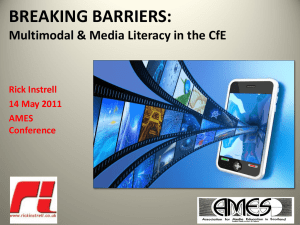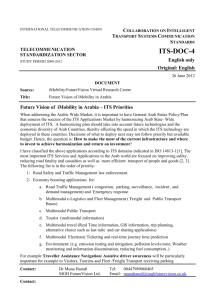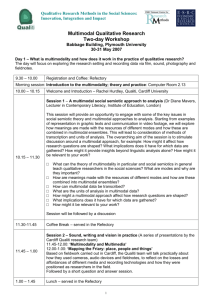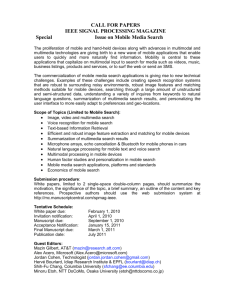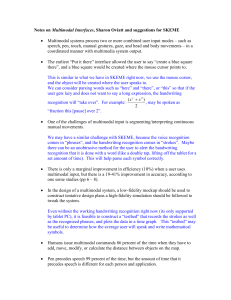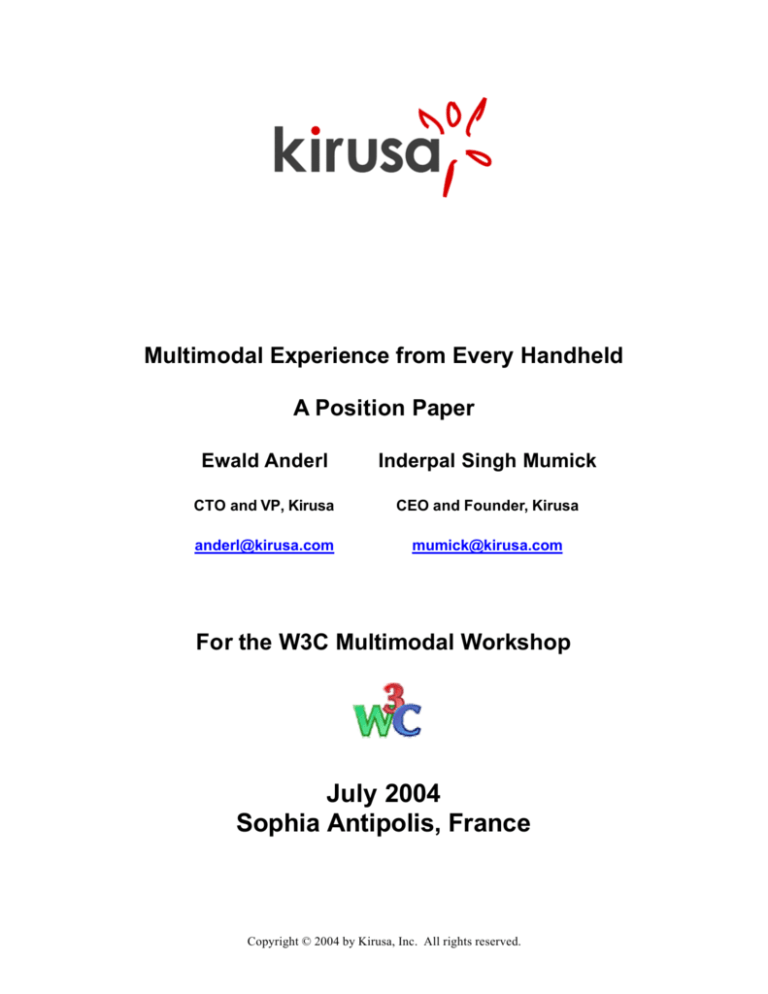
Multimodal Experience from Every Handheld
A Position Paper
Ewald Anderl
Inderpal Singh Mumick
CTO and VP, Kirusa
CEO and Founder, Kirusa
anderl@kirusa.com
mumick@kirusa.com
For the W3C Multimodal Workshop
July 2004
Sophia Antipolis, France
Copyright © 2004 by Kirusa, Inc. All rights reserved.
MULTIMODALITY EXPERIENCE FROM EVERY HANDHELD– A POSITION PAPER
Section I. Introduction
Today’s mobile services are limited by user interfaces that allow for voice or visual interaction,
rather than an integrated voice and visual interface. Usability problems unique to mobile devices
have prevented service and information providers from meeting their consumer wireless data
usage and revenue goals/targets. Voice interfaces allow for simplified service input and
interaction, but are not practical for conveying graphics (maps) or memory straining information
such as long lists (example, lists of messages), complex instructions, or numbers. Conversely,
visual interfaces are cumbersome to use but excellent for information output.
By combining both voice and visual interfaces, applications can exploit the strengths of each and
minimize the weaknesses of both modes. This integration, known as multimodality, seamlessly
combines speech, text and touch input with graphics, text and audio output to deliver enhanced
end user mobile applications and services. Multimodal applications such as voice SMS enhance
service usability resulting in improved customer satisfaction and usage, and can increase service
revenues.
Multimodality has been an active research area. While the research needs to continue, we also
need to develop and promote technologies and products that will take multimodality from a
research topic, into common use on every one of the 1.5 billion handheld devices around the
world.
Kirusa provides production-ready multimodal platform and multimodal application products on a
variety of different end-user devices, from common SMS mobile phones to full featured smart
devices and PDAs, and everything in between. Installed at several leading mobile carriers and
enterprises, Kirusa has products that target next generation GPRS, EDGE, 3G, WiFi, and FlashOFDM networks, as well as products that deliver multimodality on the widespread 2G networks.
In this positio n paper, we provide a brief description of how Kirusa is working to build the
technology to bring multimodality to every mobile handheld device. We discuss the current
solutions, as well as some of the areas of future work needed for widespread adoption of
multimodal solutions.
Section 2. Kirusa Solutions
2.1
Overview
Kirusa today builds and markets three products for deployment of multimodal solutions by
mobile carriers and enterprises.
•
•
KMS-IPV, Kirusa Multimodal Solution for IP Voice, for delivery of a multimodal
experience on smart devices over 3G and 2.5G mobile networks.
KMS-CV, Kirusa Multimodal Solution for Circuit Voice, for delivery of a multimodal
experience on all devices over 3G, 2.5G, and 2G mobile networks.
Page 2 of 5
Copyright © 2004 by Kirusa, Inc. All rights reserved.
7/18/2004
•
MULTIMODALITY EXPERIENCE FROM EVERY HANDHELD– A POSITION PAPER
KV.SMS, Kirusa Voice SMS Application, a packaged multimodal messaging application
for all devices over 3G, 2.5G, and 2G mobile networks.
The first two products enable delivery of a multimodal user interface for any application to a
mobile handset.
VoiceXML, ASR, and TTS
The KMS-IPV, KMS-CV, and KV.SMS work with a wide variety of VoiceXML 2.0 compliant
voice platforms, ASR engines, and text to speech products. SALT can also be supported.
2.2
Kirusa Multimodal Solution for IP Voice
Kirusa’s multimodal solution for IP Voice
is a simultaneous multimodal solution that
allows any application to be accessed
using a combination of voice and visual
modes at the same time. The
simultaneous multimodal solution consists
of a multimodal platform (KMP-IPV) and
multimodal clients (KMC-IPV) for mobile
handsets, as shown in the adjacent
architecture diagram.
Kirusa Multimodal Solution – IP Voice
multimodality in motion
Kirusa
Multimodal
Clients
Multimodal
Application
Speech
Resources
Speech Resources
(ASR/TTS)
SIP/RTP
VoiceXML/MRCP
VoiceXML
/MRCP
MM Markup
Data
DataNetwork
Network
Kirusa
Kirusa
Platform
Platform
(KMS
(KMS-CV)
-IPV)
Multimodal
Multimodal
Application
Wireless Infrastructure
The multimodal platform is the “heart” of
the multimodal solution. Functioning like
a “multimodal gateway,” the platform ties
together the activities of the client, application, and the voice browser to realize a multimodal
session based on the multimodal markup language. The voice and data connections run
simultaneously over an IP connection between the platform and the client. This mechanism
enables KMP to utilize a variety of wireless networks including GPRS, Edge, UMTS, CDMA
1X/3X, EV-DO, Flash-OFDM, and 802.11x. The platform is optimized to provide fast response
time over low bandwidth wireless networks, such as GPRS.
Reproduction Not Permitted
Kirusa Confidential and Proprietary
July 17, 2004
The Kirusa Multimodal Client is device-resident software installed via a quick and simple
download process. The multimodal client interfaces with the native visual and voice resources of
the smart handheld device. Multimodal clients are available or under development for several
smart devices, including Symbian, MS Smartphone, J2ME, Brew, and PalmOS, MS PocketPC,
and MS PocketPC Phone Edition.
2.3
Kirusa Multimodal Solution for Circuit Voice
Kirusa’s multimodal solution for Circuit Voice maintains two separate connections with the
mobile device, a circuit connection for voice, and a second connection for data. The solution
consists of a multimodal platform (KMP-CV), and supports SMS, sequential, and simultaneous
multimodality, depending on the capabilities of the device and network. No clients are required
for this solution. The architecture is as shown in the adjacent figure.
Page 3 of 5
Copyright © 2004 by Kirusa, Inc. All rights reserved.
7/18/2004
MULTIMODALITY EXPERIENCE FROM EVERY HANDHELD– A POSITION PAPER
2.4
Kirusa Voice SMS Application
The Kirusa Voice SMS (KV.SMS) application is a multimodal application that integrates voice
messaging capability with text based SMS and multimedia based MMS. Based on patent
pending technology, the application is designed for use over existing 2G and GPRS networks
and handsets, as well as over the next generation EDGE and 3G networks and handsets. The
application enables operators to launch easy to use, next generation messaging services quickly
and cost effectively without needing to upgrade or replace their current infrastructure. Operators
can choose a variety of advanced messaging services, tailored to the needs and interests of the
youth, enterprise and mass-market segments.
The Kirusa Voice SMS application allows several options for users:
• The user can initiate sending an SMS message using a voice message.
• The user can send a RingFree SM voice message, without ringing the phone.
• The user can send a message to one person, or to a group of people.
• Using patent pending Click2ListenSM technology, the user can click on an SMS message
to hear the voice message.
• The user can respond by voice, or by text to an SMS message or to a voice messages.
• On MMS handsets, the service integrates with MMS.
Section 3. Future Work
It is our position that within 3-5 years, all applications used from mobile handsets will be
multimodal. Needless to say, realization of this vision requires advances in networks, handsets,
multimodal techno logies, and emergence of appropriate business models. Initial successes are
needed to show the value to all participants in the multimodal ecosystem.
We list some of some of the areas where we see focus in the future:
1. Development of high speed wireless networks. UMTS and EV-DO networks are
beginning to be deployed across the world, providing bandwidths in excess of 150 kbs to
mobile users for the first time. Flash-OFDM networks further increase the bandwidth to
1.5 Mbs, approaching broadband speeds. 802.11x networks are becoming commonplace,
and the first WiFi handsets are being introduced this year. All these networks provide
data speeds at which it is possible to deliver an extremely compelling simultaneous
multimodal experience to the user. Multimodal technologies and applications must be
developed to take advantages of the full range of networks and devices soon to be
available.
2. Development of smart devices. Smart devices based on Symbian™, MS Smartphone™,
PalmOS™, Brew™, and Java™ are being introduced at an increasing rate by device
manufacturers and carriers around the world. Several of these are targeted at enterprise
customers. Clients need to be developed for the various smart device platforms to take
advantage of their capabilities for multimodality. At the same time, the phone platforms
need to build support for multimodality from the ground up.
3. Support of multimodality on non-smart devices. While it is tempting to focus on only
the newer smart devices when developing multimodal solutio ns it is projected that less
Page 4 of 5
Copyright © 2004 by Kirusa, Inc. All rights reserved.
7/18/2004
MULTIMODALITY EXPERIENCE FROM EVERY HANDHELD– A POSITION PAPER
4.
5.
6.
7.
8.
than 20 million smart devices will be sold in 2004, and, in 2008, only 30-40% of the
devices sold will be smart devices. In order to bring a multimodal experience to every
handheld, it is equally important to develop multimodal technologies that supports nonsmart devices.
More than vocal and visual modalities. While the early work has been on combining
the vocal and visual modalities, multimodality incorporates other modes of input, such as
ink and gestures.
Advances in spe ech recognition and synthesis. Speech recognition technologies needs
to be more robust, and more tolerant of noise from mobile devices. Distributing speech
recognition and speech synthesis between the server and devices should be explored with
the goals of improving the user experience.
Standardization of mark-up languages. The effort to standardize the multimodal
mark-up language at the W3C is a critical step for the widespread adoption of
multimodality. The availability of standards will also facilitate the availability of
multimodal authoring tools.
Applications, and more applications. As an industry we need to develop applications
that highlight the value of multimodality to a broad range of users, while providing a
clear revenue model or cost savings for the carriers or enterprises.
Leadership role by wireless carriers. As the channel to 1.5 billion customers around
the globe, it is hard to imagine a pervasive multimodal ecosystem without the wireless
carriers playing a leadership role in delivering multimodal applications to their
subscribers.
Section 4. Conclusions
Kirusa has developed core multimodal technologies and applications that provide a multimodal
experience optimized to the full range of mobile handsets, from SMS enabled handsets on 2G
networks, to smart devices on 3G networks, to Flash-OFDM enabled devices. As early adopters
of multimodality, several leading wireless carriers and enterprises, including France Telecom
and Vodafone have embraced Kirusa’s products.
Further advances in multimodal technologies will continue. We have identified several areas of
work we believe are important for widespread availability and adoption of multimodality.
Kirusa continues to invest and be at the forefront of multimodal technology in partnership with
carriers, enterprises, and technology providers.
Page 5 of 5
Copyright © 2004 by Kirusa, Inc. All rights reserved.
7/18/2004


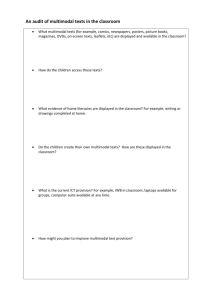
![Multimodal evidence of learning [DOC 45KB]](http://s3.studylib.net/store/data/007666677_2-5d54082e6a18fa7c91ee543af4725a90-300x300.png)
